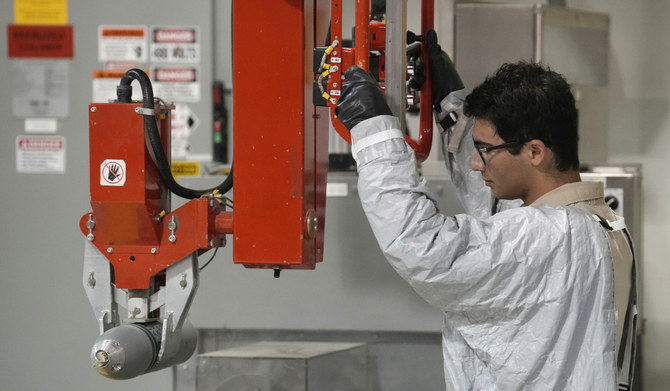
RICHMOND, Kentucky: At a sprawling military installation in the middle of the rolling green hills of eastern Kentucky, a milestone is about to be reached in the history of warfare dating back to World War I.
Workers at the Blue Grass Army Depot are close to destroying rockets filled with GB nerve agent that are the last of the United States’ declared chemical weapons and completing a decadeslong campaign to eliminate a stockpile that by the end of the Cold War totaled more than 30,000 tons.
The weapons’ destruction is a major watershed for Richmond, Kentucky and Pueblo, Colorado, where an Army depot destroyed the last of its chemical agents last month. It’s also a defining moment for arms control efforts worldwide.
The U.S. faces a Sept. 30 deadline to eliminate its remaining chemical weapons under the international Chemical Weapons Convention, which took effect in 1997 and was joined by 193 countries. The munitions being destroyed in Kentucky are the last of 51,000 M55 rockets with GB nerve agent — a deadly toxin also known as sarin — that have been stored at the depot since the 1940s.
By destroying the munitions, the U.S. is officially underscoring that these types of weapons are no longer acceptable in the battlefield and sending a message to the handful of countries that haven’t joined the agreement, military experts say.
“One thing that we’re really proud of is how we’re finishing the mission. We’re finishing it for good for the United States of America,” said Kim Jackson, manager of the Pueblo Chemical Agent-Destruction Pilot Plant.
Chemical weapons were first used in modern warfare in World War I, where they were estimated have killed at least 100,000. Despite their use being subsequently banned by the Geneva Convention, countries continued to stockpile the weapons until the treaty calling for their destruction.
In southern Colorado, workers at the Army Pueblo Chemical Depot started destroying the weapons in 2016, and on June 22 completed their mission of neutralizing an entire cache of about 2,600 tons of mustard blister agent. The projectiles and mortars comprised about 8.5% of the country’s original chemical weapons stockpile of 30,610 tons of agent.
Nearly 800,000 chemical munitions containing mustard agent were stored since the 1950s inside row after row of heavily guarded concrete and earthen bunkers that pock the landscape near a large swath of farmland east of Pueblo.
The weapons’ destruction alleviates a concern that civic leaders in Colorado and Kentucky admit was always in the back of their minds.
“Those (weapons) sitting out there were not a threat,” Pueblo Mayor Nick Gradisar said. But, he added, “you always wondered what might happen with them.”
In the 1980s, the community around Kentucky’s Blue Grass Army Depot rose up in opposition to the Army’s initial plan to incinerate the plant’s 520 tons of chemical weapons, leading to a decadeslong battle over how they would be disposed of. They were able to halt the planned incineration plant, and then, with help from lawmakers, prompted the Army to submit alternative methods to burning the weapons.
Craig Williams, who became the leading voice of the community opposition and later a partner with political leadership and the military, said residents were concerned about potential toxic pollution from burning the deadly chemical agents.
Williams noted that the military eliminated most of its existing stockpile by burning weapons at other, more remote sites such as Johnston Atoll in the Pacific Ocean or at a chemical depot in the middle of the Utah desert. But the Kentucky site was adjacent to Richmond and only a few dozen miles away from Lexington, the state’s second-largest city.
“We had a middle school of over 600 kids a mile away from the (planned) smokestack,” Williams said.
The Kentucky storage facility has housed mustard agent and the VX and sarin nerve agents, much of it inside rockets and other projectiles, since the 1940s. The state’s disposal plant was completed in 2015 and began destroying weapons in 2019. It uses a process called neutralization to dilute the deadly agents so they can be safely disposed of.
The project, however, has been a boon for both communities, and facing the eventual loss of thousands of workers, both are pitching the pool of high-skilled laborers as a plus for companies looking to locate in their regions. AFP
Please visit our website London Institute of Peace Research for latest peace news


